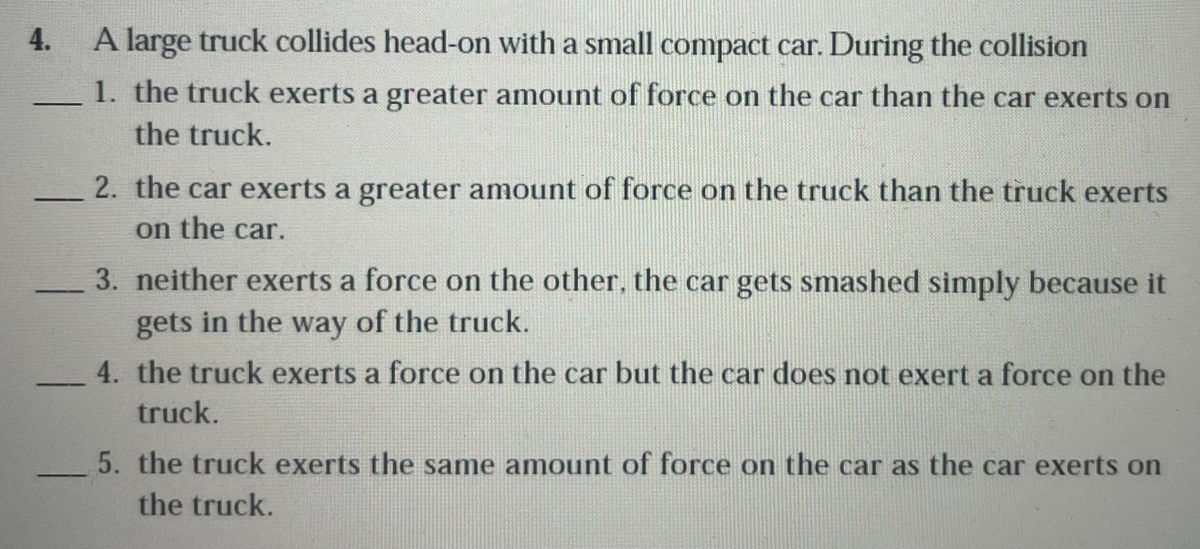4. A large truck collides head-on with a small compact car. During the collision 1. the truck exerts a greater amount of force on the car than the car exerts on the truck. 2. the car exerts a greater amount of force on the truck than the truck exerts on the car. 3. neither exerts a force on the other, the car gets smashed simply because it gets in the way of the truck. 4. the truck exerts a force on the car but the car does not exert a force on the truck. 5. the truck exerts the same amount of force on the car as the car exerts on the truck.
4. A large truck collides head-on with a small compact car. During the collision 1. the truck exerts a greater amount of force on the car than the car exerts on the truck. 2. the car exerts a greater amount of force on the truck than the truck exerts on the car. 3. neither exerts a force on the other, the car gets smashed simply because it gets in the way of the truck. 4. the truck exerts a force on the car but the car does not exert a force on the truck. 5. the truck exerts the same amount of force on the car as the car exerts on the truck.
Glencoe Physics: Principles and Problems, Student Edition
1st Edition
ISBN:9780078807213
Author:Paul W. Zitzewitz
Publisher:Paul W. Zitzewitz
Chapter6: Motion In Two Dimensions
Section: Chapter Questions
Problem 97A
Related questions
Question

Transcribed Image Text:4.
A large truck collides head-on with a small compact car. During the collision
1. the truck exerts a greater amount of force on the car than the car exerts on
the truck.
2. the car exerts a greater amount of force on the truck than the truck exerts
on the car.
3. neither exerts a force on the other, the car gets smashed simply because it
gets in the way of the truck.
4. the truck exerts a force on the car but the car does not exert a force on the
truck.
5. the truck exerts the same amount of force on the car as the car exerts on
the truck.
Expert Solution
Step 1
We know from the Newton's third law that "To every action there is equal and opposite reaction". So we can easily say that option 5 is the correct answer.
Here action is the force that truck exerts on the car and reaction is the force that car exerts on the truck.
Therefore during the collision time, it can be said that the small compact car exerts the same amount of force as the large truck exerts on the small compact car in order to satisfy the Newton's third law.
Trending now
This is a popular solution!
Step by step
Solved in 2 steps

Knowledge Booster
Learn more about
Need a deep-dive on the concept behind this application? Look no further. Learn more about this topic, physics and related others by exploring similar questions and additional content below.Recommended textbooks for you

Glencoe Physics: Principles and Problems, Student…
Physics
ISBN:
9780078807213
Author:
Paul W. Zitzewitz
Publisher:
Glencoe/McGraw-Hill

College Physics
Physics
ISBN:
9781938168000
Author:
Paul Peter Urone, Roger Hinrichs
Publisher:
OpenStax College

Physics for Scientists and Engineers, Technology …
Physics
ISBN:
9781305116399
Author:
Raymond A. Serway, John W. Jewett
Publisher:
Cengage Learning

Glencoe Physics: Principles and Problems, Student…
Physics
ISBN:
9780078807213
Author:
Paul W. Zitzewitz
Publisher:
Glencoe/McGraw-Hill

College Physics
Physics
ISBN:
9781938168000
Author:
Paul Peter Urone, Roger Hinrichs
Publisher:
OpenStax College

Physics for Scientists and Engineers, Technology …
Physics
ISBN:
9781305116399
Author:
Raymond A. Serway, John W. Jewett
Publisher:
Cengage Learning


Physics for Scientists and Engineers: Foundations…
Physics
ISBN:
9781133939146
Author:
Katz, Debora M.
Publisher:
Cengage Learning

An Introduction to Physical Science
Physics
ISBN:
9781305079137
Author:
James Shipman, Jerry D. Wilson, Charles A. Higgins, Omar Torres
Publisher:
Cengage Learning